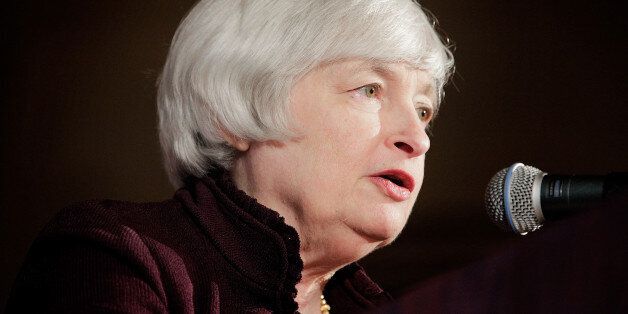
WASHINGTON, June 18 (Reuters) - The Federal Reserve on Wednesday slashed its forecast for U.S. economic growth this year but expressed confidence the recovery was largely on track and would allow it to begin raising interest rates in 2015.
Despite the cut from around 2.9 percent to a range of between 2.1 and 2.3 percent for 2014 growth, the central bank pushed ahead with plans to wind down one of its main stimulus programs by the end of the year, as widely expected.
It reduced its monthly asset purchases from $45 billion to $35 billion a month, divided between $20 billion of Treasury securities and $15 billion of mortgage-backed debt.
"Economic activity will expand at a moderate pace and labor market conditions will continue to improve gradually," the Fed said in its policy statement. "Household spending appears to be rising moderately and business fixed investment resumed its advance."
Updated economic forecasts from Fed officials showed an economy slammed by bad weather at the start of the year but poised to continue growing. Fed officials maintained their growth projections for 2015 and 2016, and foresaw a faster drop in unemployment and tame inflation.
In updated interest rate projections, Fed officials still foresaw rates beginning to rise next year. Of 16 individual rate hike projections, the median interest rate stood at 1 percent by the end of 2015, the same as in March.
However, Fed officials projected a slightly more aggressive path of interest rate hikes for the following year, with the median placed at 2.5 percent versus 2.25 percent in March.
Fed members also lowered their projections for long-term interest rates, a potential sign of reduced confidence in the economy's long-run potential. The median projection was for a long-term federal funds rate of around 3.75 percent, compared to around 4 percent in March.
Its policy statement changed little from the one issued after its last meeting in April, repeating that interest rates would remain near zero "for a considerable time" after the bond buying ends. The Fed said unemployment remained "elevated" despite recent job growth, and noted that its preferred measure of inflation was still running below its 2 percent target.
There were no further details provided in the statement about the Fed's plans to exit other aspects of the extraordinary measures it has taken in response to the crisis. For now, the Fed said it would continue reinvesting proceeds of its asset holdings as they mature.
Fed Chair Janet Yellen holds a news conference to discuss the central bank's views on the economy and monetary policy at 2:30 p.m. EDT (1830 GMT).
The Fed cut overnight rates to near zero in December 2008 as it battled the financial crisis and deep recession. The timing and pace of renewed rate increases is one of the key decisions facing the central bank as the current recovery evolves.
In its updated quarterly forecasts, the Fed took into account the sour start the economy got this year after severe winter weather crippled activity in major cities around the country. The government said last month that GDP shrank at a 1 percent annual rate, and economists say data since then imply a much deeper contraction.
Although growth now appears to be rebounding, there remain weak spots, particularly in the housing sector. Fed officials described risks to the economy and labor market as "nearly balanced."
(Reporting by Howard Schneider; Editing by Paul Simao)
